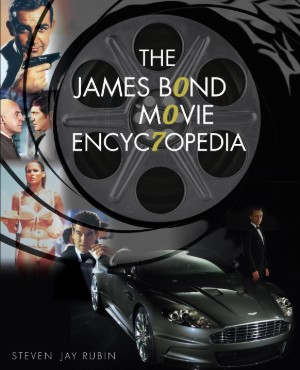★★★★ The third James Bond film produced by Albert R. Broccoli and Harry Saltzman. US release date: December 25, 1964. Budget: $3.5 million. Worldwide box office gross: $124.9 million (US domestic gross: $51.1 million; international gross: $73.8 million).[1] Running time: 111 minutes.
The Setup
Having devastated a heroin smuggling operation in South America, James Bond (Sean Connery) is sent to Miami’s swanky Fontainebleau Hotel to observe one Auric Goldfinger (Gert Fröbe), a suspected gold smuggler. Bond foils Goldfinger’s rigged gin game with Mr. Simmons (Austin Willis), beds the suspect’s stunning girlfriend, Jill Masterson (Shirley Eaton), gets knocked out by his Korean manservant (Harold Sakata), then witnesses Masterson’s unusual death: she’s painted from head to toe in gold. Returning to London, Bond is ordered to tail Goldfinger to Austria, where he discovers that not only is his nemesis a gold smuggler, with a pilot named Pussy Galore (Honor Blackman), but he’s also planning something much bigger—something called Operation Grand Slam.
Behind the Scenes
Although From Russia with Love has a better story, Goldfinger is the best film in the James Bond series. It elevated the series to a level of pop entertainment that very few films achieve. Indeed, when Goldfinger was released during Christmastime 1964, it became a worldwide phenomenon, with many theaters staying open twenty-four hours a day to accommodate the crowds. It was the first megahit film of the modern era. Past box office winners had established their records over a long period of release time, but Goldfinger rewrote the record book from its first day in release. No film had ever made as much money in so little time. Why? Goldfinger was a big fantasy story with three elements that have never quite been equaled.
First, it has Goldfinger himself, the best of all possible villains, with the most perfect of all schemes. He’s also accompanied by Oddjob, a wicked manservant who talks through a very lethal bowler. Second, the film has the most alluring gallery of women ever seen in the series, and introduces them in outrageous fashion. Third, it has that Aston Martin DB5 with modifications. No film prop or gadget has ever been idolized more than that car. Remember, this was the mid-1960s, the era of the space race between the United States and the Soviet Union, when high technology was all the rage. For months, the Aston Martin was the talk of every school campus in the world.
However, there were some problems along the way. According to editor Peter Hunt, the first assembly of the film was so bad that producers Albert R. Broccoli and Harry Saltzman were actually prepared to shelve the film and release Thunderball next.[2] It’s hard to believe considering how amazingly good the finished film was, but apparently the producers were concerned that Bond is a rather inactive hero for a good chunk of the film (from the time he’s shot with the tranquilizer dart until he battles Oddjob inside Fort Knox). After the first cut, Hunt said, shots were inserted that improved the way the film played, the shelving idea was abandoned, and Goldfinger became a legendary addition to the series. That’s thanks in large part to Richard Maibaum’s script, which cleverly updated the Ian Fleming novel, Guy Hamilton’s slam-bang direction, and John Barry’s memorable score.
| James Bond | Sean Connery |
| Auric Goldfinger | Gert Fröbe |
| Pussy Galore | Honor Blackman |
| Jill Masterson | Shirley Eaton |
| Tilly Masterson | Tania Mallet |
| Oddjob | Harold Sakata |
| M | Bernard Lee |
| Q | Desmond Llewelyn |
| Mr. Solo | Martin Benson |
| Felix Leiter | Cec Linder |
| Mr. Simmons | Austin Willis |
| Miss Moneypenny | Lois Maxwell |
| Midnight | Bill Nagy |
| Capungo | Alf Joint |
| Old Lady Gatekeeper | Varley Thomas |
| Bonita | Nadja Regin |
| Sierra | Raymond Young |
| Colonel Smithers | Richard Vernon |
| Brunskill | Denis Cowles |
| Kisch | Michael Mellinger |
| Mr. Ling | Burt Kwouk |
| Strap | Hal Galili |
| Henchman | Lenny Rabin |
| Sydney | Tricia Muller |
| Dink | Margaret Nolan |
| Mei-Lei | Mei Ling |
| Director | Guy Hamilton |
| Screenplay by | Richard Maibaum |
| Paul Dehn | |
| Producers | Harry Saltzman |
| Albert R. Broccoli | |
| Director of Photography | Ted Moore, B.S.C. |
| Music composed and conducted by | John Barry |
| Title song performed by | Shirley Bassey |
| Title song lyrics by | Leslie Bricusse |
| Anthony Newley | |
| Production Designer | Ken Adam |
| Art Director | Peter Murton/td> |
| Assistant Art Directors | Michael White |
| Maurice Pelling | |
| Set Dresser | Freda Pearson |
| Wardrobe Supervisor | Elsa Fennell |
| Wardrobe Mistress | Eileen Sullivan |
| Wardrobe Master | John Hilling |
| Makeup | Paul Rabiger |
| Basil Newall | |
| Hairstylist | Eileen Warwick |
| Production Manager | L. C. Rudkin |
| Assistant Director | Frank Ernst |
| Continuity | Constance Willis |
| Camera Operator | John Winbolt |
| Action Sequences by | Bob Simmons |
| Stuntman | George Leech |
| Choreographer | Selina Wylie |
| Title Designer | Robert Brownjohn |
| Special Effects | John Stears |
| Special Effects Assistant | Frank George |
| Sound Recordists | Dudley Messinger |
| Gordon McCallum | |
| Editor | Peter Hunt |
| Assembly Editor | Ben Rayner |
| Dubbing Editors | Norman Wanstall |
| Harry Miller | |
[1] “Goldfinger (1964),” The Numbers, accessed May 20, 2020, https://www.the-numbers.com/movie/Goldfinger.
[2] Peter Hunt, interview by Steven Jay Rubin, London, June 21, 1977.

